- Home
- Dick Francis
Lester: The Official Biography Page 17
Lester: The Official Biography Read online
Page 17
Brilliantine, hating the ground, came in eleventh.
It was never his riding alone that made Lester unique as a jockey but his thought-out judgments and understanding of what horses liked. He chose wrong sometimes, inevitably, but only a fraction of the number of times that he chose right.
Before the Irish Guinness Oaks, he had a choice of the three best fillies: Juliette Marny, the French filly Nobiliary, and Vincent O'Brien's Tuscarora. He chose Juliette Marny again, and in a desperate finish sent her shooting to the front in the last two or three strides to overhaul Tuscorora by a neck, with Nobiliary an undisgraced third. One could hardly be more right.
In 1975, a year crowned for him by the award of the OBE, Lester took his sixth Ascot Gold Cup, and altogether won eight of the Royal meeting's twenty-four races.
Vincent O'Brien trained six winners, four with Lester and the other two with lightweight Sardinian Gianfranco Dettori, an unusual choice of jockey made at Lester's suggestion. Dahlia it was, however, who became the overall star of those years, although Lester didn't ride her regularly until half way through her four-yearold season. He partnered her only once before that, in her very first outing when she won a good 5-furlong race at Deauville for her French trainer Maurice Zilber and American owner Nelson Bunker Hunt. She ran three more times without winning at two, but at three had much success, chiefly in the hands of stable jockey Bill Pyers, but sometimes in Yves Saint-Martin's. The only filly consistently to beat her was the flashing Allez France, owned by Daniel Wildenstein, trained by Albert Klimscha and also ridden by Yves Saint-Martin.
Lester often rode Nelson Bunker Hunt's English-trained horses, especially those with Bernard van Cutsem, and it was at the owner's behest that Lester took the ride when Dahlia came over for the King George VI and Queen Elizabeth Stakes at Ascot in July 1974. Trainer Maurice Zilber, always keen on Lester, was totally in favour. As in the year before, when she had skipped away from Rheingold, Dahlia made her way through the field, hit the front a good way from home and stayed on to win with ease by two and a half lengths.
Next time out, she won the Benson and Hedges Gold Cup by the same margin at York, and then crossed the Atlantic to run at Belmont Park in New York. Ron Turcotte, a Canadian jockey, rode and won on her there, but two weeks later Lester was back in the saddle for the Canadian International Championship at Toronto.
Lester, arriving from England a few scant hours in advance, rode one of those races guaranteed to be bad for a watching owner's heart, appearing to be hopelessly shut in too near to home and then streaking through a late opening to win at high speed.
Dahlia's time at Toronto was a record for the Woodbine course.
A year earlier, Dahlia had unaccountably come nowhere in the Arc de Triomphe (behind Lester on Rheingold) but had then gone to Laurel and with Bill Pyers won the Washington International. After the Toronto win, she again ran at Laurel, Lester flying over for the second time in a fortnight, but this time she met her match.
Lester's two journeys were a clear statement that he was no longer fighting to be champion. By late October, he and Pat Eddery were both within reach of the honour, the younger jockey very slightly in front. Lester went off to Canada and Washington in search of big prizes, Pat turning down a ride at Laurel to concentrate on numbers at home. In the next few years after he stopped chasing the crown, Lester's places on the jockeys' list were: in 1972, fourth; in 1973, second; in 1974, second; and in 1975, third. If one counted in his overseas wins, nothing much had changed.
Dahlia and Lester again won the Benson and Hedges Gold Cup in 1975, her last success in Europe. In all, she amassed well over a million and a half dollars in prize money for Nelson Bunker Hunt, and had won in every country she visited -France, England, Canada and her original homeland, the United States.
She ran best when she'd been travelling, Lester says, as, unlike many horses, she seemed to enjoy it. She was tough and game and keen to race, pulling quite hard. She liked and was much better in a fast-run race, and she was never ready to produce anything much until the weather was warm, from mid-June onwards. After her European career, her owner sent her for a year to be trained in California where she continued to win many big races; and Lester sums her up simply as "tremendous".
Empery, like Dahlia, was sired by Vaguely Noble, owned by Nelson Bunker Hunt and trained in France by Maurice Zilber.
Maurice Zilber was by birth Egyptian and had been twelve times leading trainer in his native country before leaving there with nothing during the Nasser upheavals.
Arriving penniless in France, he immediately set about gathering together a new stable, and such was his skill, his forcefulness and his persuasive tongue that he was back high on the racing map in exceedingly short time.
A trainer of the very highest class, he is somewhat volatile in temperament and sometimes on non-speaking terms with his owners because of differences of opinions as to how the horses should be run. Among them on occasion was Nelson Bunker Hunt. Nevertheless, the two strongminded men, both of a sturdy presence, scored a long string of successes together, glued in spite of irritations.
Nelson Bunker Hunt at that time had countless horses in training and on stud farms in Europe and America and was at the height of the era of his success. Empery was not, in fact, reckoned to be his best colt in 1976: he had another charismatic threeyear-old in Youth.
Empery ran three times as a two-year-old, winning one small race and making not much show in the Grand Criterium. First time out in his threeyear-old season Lester rode him in the Prix d'Essai des Poulains, the French equivalent of the Two Thousand Guineas, but although he ran well he finished fourth. Next time out, much the same result. On the third try, with Bill Pyers, he finished third in the Prix Lupin, the race being won by his stable-mate Youth. Youth, ridden as usual by Freddie Head, then went on to win the Prix du jockey Club (French Derby) on the Sunday after Empery ran at Epsom.
Although useful and in Lester's words "a nice horse", Empery had up to that time made no particular mark, and it was only because Lester had accepted the ride on him that he was in the news much at all. As in Joe Lawson's days, it was the trainer alone whose faith was unshaken.
Lester himself thought it likely he would be beaten by Wollow, which had fought indomitably to seize the Two Thousand Guineas for Henry Cecil, with Gianfranco Dettori in the saddle. Wollow, sired by Lester's old friend and winner, Wolver Hollow, was proving the prolific winner he was to be all his racing life. Lester said aloud that it would take a gunshot to stop Wollow winning the Derby. Maurice Zilber got to hear of Lester's published opinions and telephoned to tell him strongly in his French-Egyptian accent that Empery had much improved during the past week and was in peak form to win: and Lester again set off at Epsom with the trainer's confidence overriding his doubts.
Lester did most particularly want to win, as if he did he would set an all-time record of seven victories in the big race. He already shared the record with Steve Donoghue and Jem Robinson, but being ahead on his own meant much more. Empery was, of course, unknown to British racegoers as all his runs had so far been in France, and because of this he started at a generous 10-1, with Wollow, the only one better backed, a hot favourite at 11-10.
Lester rode the Derby to his well-tried pattern, Empery being easy to ride with no wayward quirks of temperament. He set off well, stayed in fourth or fifth place until the last two furlongs, then quickened in a flying straight line well away from the rails to win in the end with apparent ease by three lengths from Relkino, with Oats third.
The supposedly unbeatable Wollow finished an undistinguished fifth, to post-mortem mutterings of "ground too soft"; and subsequently Wollow and his Italian jockey retrieved their dignity by winning the Eclipse (on a disqualification), the Sussex Stakes and the Benson and Hedges Gold Cup.
Empery still isn't considered toy some to have been a truly great horse, but on his day he beat the greater Wollow out of sight. Nelson Bunker Hunt wasn't there to lead in his risen star, his
daughter Betsy deputising. The owner himself listened to the race on the telephone back home in Dallas where his wife had arranged a silver wedding party, oblivious to the clash of dates.
Empery had one more run, in the Irish Sweeps Derby three weeks after Epsom. This time he started favourite but couldn't quicken when challenged and was beaten two and a half lengths by another American-bred, French-trained horse, Malacate.
Empery, his Derby reputation more or less intact, went back over the ocean to stud.
In 1976, Lester rode a great deal for Sir Noel Murless, the old partnership reasserting itself for one last flourish as the great trainer was to retire at the end of the season.
Together, they won twentythree more races, notably the Royal Hunt Cup at Royal Ascot with jumping Hill, and the Richmond Stakes and the Laurent-Perrier Champagne Stakes with a warmly promising two-year-old J. O . Tobin.
Lester's last ever-win for Noel was Tinsley Green at Lingfield on 2 November, a small prize but a big milestone, charged with nostalgic mutual memories of great moments shared.
In numbers of wins, 1976 wasn't notable for Lester: he scored only 87 from a small (for him) pool of 402 races in Great Britain. In prestige they were colossal, as apart from the Derby he won the Yorkshire Cup on Bruni, the Coronation Cup on Quiet Fling and the Ascot Gold Cup, as in the previous year, on Sagaro. Also the Nassau Stakes with Roussalka and the Cesarewitch with John Cherry.
The decade of the seventies saw a great expansion of commercial sponsorship of races. New races arose, old races were adopted, the pattern of prize money changed.
Historic old races, those left without sponsors, lost some of their standing, while others advanced in importance. The Cheveley Park Stakes and the Dewhurst Stakes, both for top two-year-olds, were adopted and endowed by bookmaker William Hill, and in 1976 Lester won them both.
As the familiar Murless name faded away, a new name began to appear, heralding a whole new age. Lester won the Cheveley Park on Durtal, trained by Barry Hills, and the Dewhurst on Vincent's new white hope, The Minstrel.
Both horses were owned by the newcomer: Robert Sangster.
-
18 The Minstrel and Alleged
THE ink on the Press huzzas for Lester's seventh victory in the Derby was hardly dry when he set out on the path to the eighth. Among Vincent O'Brien's large 1976 intake of two-year-old colts, the best looked like being not only The Minstrel but also Be My Guest, Valinsky, Artaius and Alleged.
Be My Guest, like The Minstrel, was sired by Northern Dancer, and Valinsky was by Nijinsky, himself also by Northern Dancer. Artaius's sire was Round Table, Alleged's was Hoist the Flag: all five colts had thus crossed the Atlantic.
During 1976, Lester won on all of the first three, all in Ireland. Alleged came to hand very late indeed and won his only two-year-old race on 1 November, ridden by Thomas Murphy. Artaius, too, ridden by the same jockey, ran once and late and was beaten by Orchestra. They, it was clear, were unlikely to be ready for the Derby.
Opening the 1977 campaign, Vincent first of all sent his unbeaten three-time winner The Minstrel to Ascot for what the betting public expected to be an odds-on doddle; and to all appearances, things went well. The horse won. From Lester's view point, though, the race did The Minstrel no good. The ground was soft which drained a lot of the colt's stamina. He had to struggle a bit to win, and near the end he was drifting slightly to the left, often a sign of fatigue.
When The Minstrel came over for the Two Thousand Guineas, Lester didn't think he looked in top condition, but hoped it was because of the cold wet spring which hadn't been helpful to horses in general. The Minstrel ran fairly well but could produce no finishing speed, and in a hard race was beaten into third place by two lengths.
Vincent took him home to Ireland and decided to try for the Irish Two Thousand Guineas three weeks later. Lester says this was again a very hard race, which The Minstrel was unlucky to lose. Nebbiolo, who finished third, ran into the back of him a furlong and a half out, unbalancing him, and Pampapaul, a moderately good performer trained in Ireland by Noel Murless's brother Stuart, came with a strong run on the outside and beat him by a short head. As preparation for the Derby, the three hard races in a row, two of them lost, were all fairly discouraging.
Be My Guest made a much more positive show first time out, coming over for the Epsom Spring Meeting and winning the Ladbroke Blue Riband Trial Stakes by a clear three lengths, untroubled. Next time out, though, he like Artaius lost by two lengths to Orchestra, a useful horse but not Derby class.
Valinsky came out at The Curragh in May and in a trial race was soundly beaten by Alleged; definitely not what had been expected. Vincent by now was scratching his head and wondering which, if any, he could send to Epsom for the big race. It was unthinkable for him not to be represented at all, but if all his colts looked like flopping, maybe it would be better for everyone's reputation if he kept them at home.
The owners disagreed. Sir Charles Clore wanted Valinsky to run and Mrs. A.
Manning felt the same about Be My Guest, sink or swim. Vincent decided at that point to let only those two take their chances. However, after discussing with Lester the whys and wherefores of the Irish Two Thousand Guineas, it was decided The Minstrel should also take his place at Epsom and he, Lester, would ride. Vincent, with enormous respect for Lester's judgment, revised his plans and shipped all three, misgivings or not.
The Minstrel was a bright chestnut with a white face and four white socks, markings often considered undesirable until the "handsome is as handsome does" rule takes over. He was jointly owned by Robert Sangster, Vincent and two or three others, but ran always in the increasingly familiar Sangster colours of blue, green and white. The Sangster silks and The Minstrel's hide made a shiningly vivid combination, impossible to miss.
The Minstrel was in addition excitable by nature, and Vincent was afraid the noise of the Epsom crowds would upset him. As a solution, he stuffed cotton-wool into the colt's ears in the saddling boxes, with Lester removing the O'Brien-style tranquilliser once he'd arrived unfussed at the start.
Many hearts sank when the ultra-visible pair set off slowly from the Derby gate. The Minstrel was never a quick starter, Lester says, but much else that day was in his favour. The ground was hard, which the little horse liked, and the track was left-handed, the way he went best. Blushing Groom, a very good unbeaten French horse, winner of the French Two Thousand Guineas, started hot favourite, but Lester, who had been beaten by him in the Grand Criterium the previous autumn, didn't think he would stay the longer distance at Epsom, which The Minstrel might.
Starting willy-nilly at the rear of the large field, Lester reckons he had fifteen horses ahead to beat when they had gone a third of the way. By the downhill approach to Tattenham Corner, he had passed a few but still lay about tenth.
Hot Grove, ridden by Willie Carson, came past Lester on the outside and began to make a run. Lester, thinking Hot Grove a danger because of having won the Chester Vase on him only four weeks earlier, decided it would be best to stay close, and went after him. Both horses, on the curve, shot up to be level with the leaders, passing ten horses inside a furlong. There was a bit of interference on the inside, Lester says, but on the outside he and Willie had a clear run.
When the field straightened after Tattenham Corner, Hot Grove went into the lead, with Lester on his outside still following. All the way up the straight, The Minstrel chased Hot Grove, and for most of the way that's how it looked to Lester that they would finish. He could make no impression until inside the last furlong, when slowly the gap began to close. At one hundred yards from the post, The Minstrel was second by three-quarters of a length and the jockey was hopeful: at fifty yards, by half a length, and the jockey was sure; and in the last twenty-five yards they broke Willie Carson's heart.
Lester says The Minstrel won (by a neck) because he outran Hot Grove over the distance. To Lester, it was always the horse that won, not himself. He says, "He won", not "I won".
>
The Minstrel, he says, was a good tough horse who, at the time of the Derby, was developing fast and just coming to his full strength. Pampapaul, who had beaten him in Ireland only two weeks earlier, could finish no nearer than fifteen lengths back.
Valinsky finished tenth with Be My Guest on his heels, eleventh. Blushing Groom came third by five lengths, not making the distance, as Lester had thought.
The Minstrel's golden time of harvest lasted seven and a half dramatic weeks. After the Epsom fireworks, the next outing was the Irish Sweeps Derby in the second half of June where Lester and The Minstrel lined up at The Curragh in a field of fifteen.
The race went sweetly enough until near the end, when The Minstrel, leading by a clear margin, swerved suddenly across the . path of Lucky Sovereign who was chasing him home. Naturally enough, Lucky Sovereign's jockey, Frankie Durr, lodged an objection, saying he had been hampered, his horse having had to shorten his stride. The Stewards debated for a tense half-hour before announcing, to Vincent's vast relief, that the result would stand. The Minstrel, it was reckoned, had been far enough in front for his crossing of Lucky Sovereign's path to have had no effect on the outcome.

 Bolt
Bolt Proof
Proof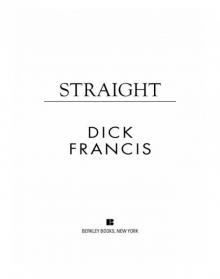 Straight
Straight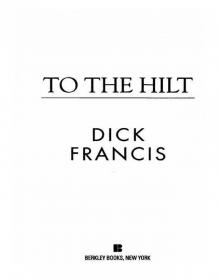 To the Hilt
To the Hilt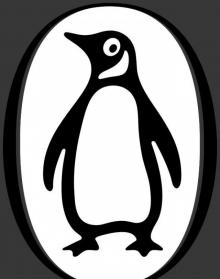 High Stakes
High Stakes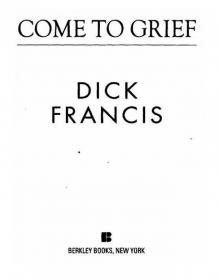 Come to Grief
Come to Grief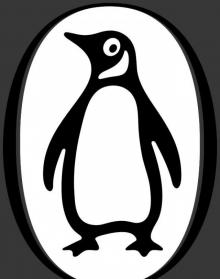 Odds Against
Odds Against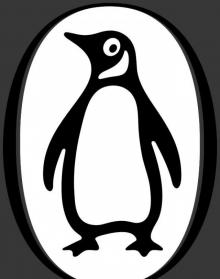 Knock Down
Knock Down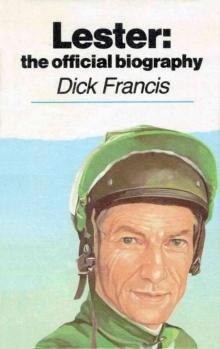 Lester: The Official Biography
Lester: The Official Biography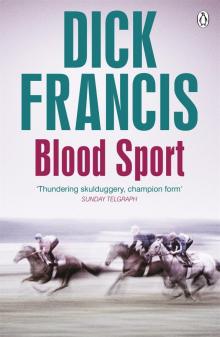 Blood Sport
Blood Sport Trial Run
Trial Run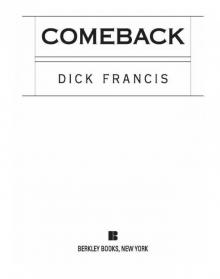 Comeback
Comeback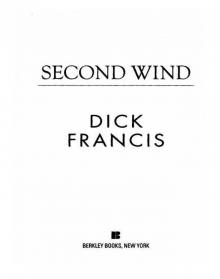 Second Wind
Second Wind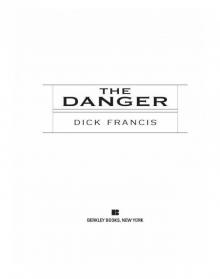 The Danger
The Danger Under Orders sh-4
Under Orders sh-4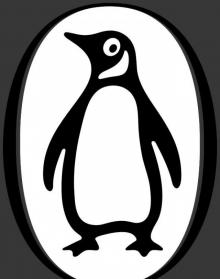 Break In
Break In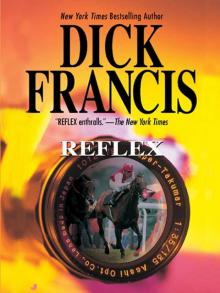 Reflex
Reflex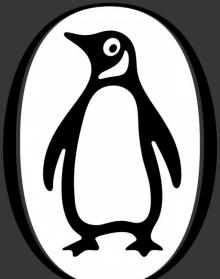 Dead Heat
Dead Heat Dick Francis's Damage
Dick Francis's Damage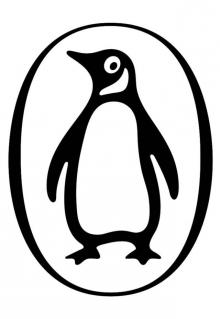 The Edge
The Edge Wild Horses
Wild Horses Longshot
Longshot Slay Ride
Slay Ride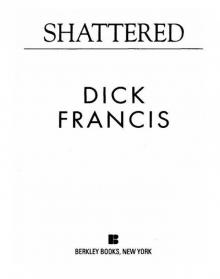 Shattered
Shattered Banker
Banker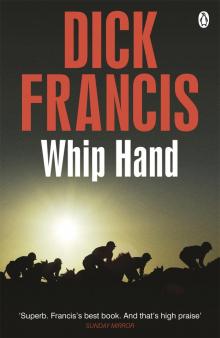 Whip Hand
Whip Hand Even Money
Even Money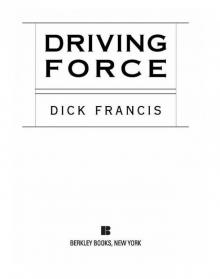 Driving Force
Driving Force Decider
Decider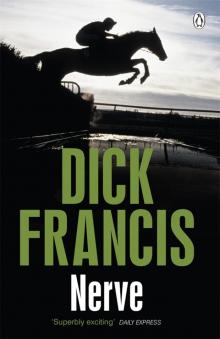 Nerve
Nerve Hot Money
Hot Money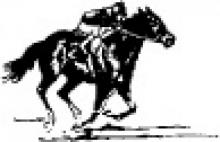 Field of Thirteen
Field of Thirteen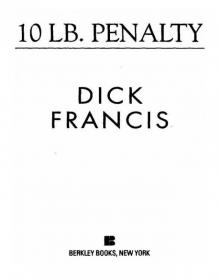 10 lb Penalty
10 lb Penalty Dead Cert
Dead Cert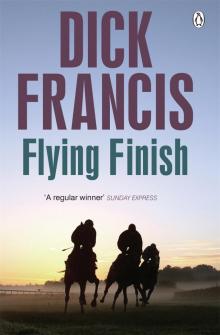 Flying Finish
Flying Finish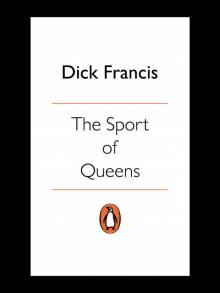 The Sport of Queens
The Sport of Queens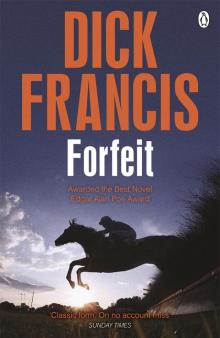 Forfeit
Forfeit Smokescreen
Smokescreen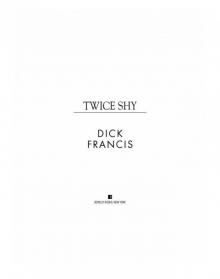 Twice Shy
Twice Shy Silks
Silks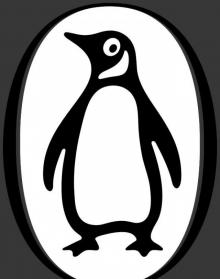 Enquiry
Enquiry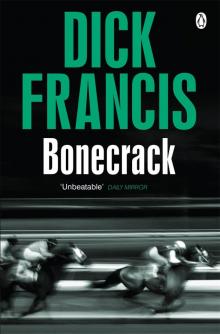 Bonecrack
Bonecrack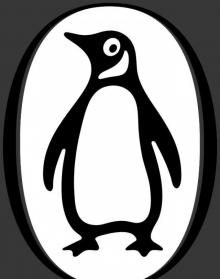 For Kicks
For Kicks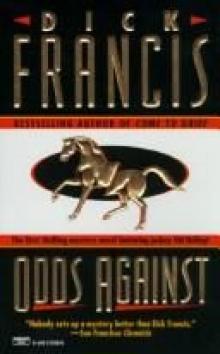 Odds against sh-1
Odds against sh-1 Rat Race
Rat Race Crossfire
Crossfire